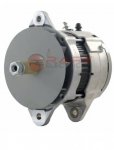Oh I just noticed that video you added. My alternator was doing exactly this. Did that persistent pulsing of the needle go away after cleaning the VR connector/harness?
Just got back earlier from a 400 miler RT to the heart of Utah to deliver a snowblower. Yesterday I was quite worried about the VR wave action so I put the 2 pulled batteries back in there, full set of 4 now. When I test ran the truck with 2 batts after the lbcd delete, the voltage kept creeping up to almost 30 , and wavy, on just a 10mile ride. So I figured if I lose the VR on the trip, I'll have a lot of battery to make it to a gas station at least. When I then test ran the 4 batts, the VR calmed down and it was steady at 29, so I felt like it might be good.
On the trip today, I put the DMM on the PDP to track 24v bus. (The LBCD is deleted and connector to batt switch is disconnected). So, Expecting schizophrenia, instead I got a town hall meeting about streets' budget. Uneventful as heck! No waves at all. Plus, on the first 200mi leg, the voltage was steady at 28.5 no waves and then it barely crept up to 29 after 3 hours. It was locked on 28.5 for awhile.
On the return leg, it locked down to 28 almost exactly, 28.1-28 the whole run, 3 hours and not even a blip above 28.1, regardless of speed (80 thru Utah! ECO reigned supreme!). I even stopped twice to use the rest area. On restart both times, it went right to 28 and stuck like glue. Curiosity is percolating! The VR got tighter after every ignition reset. WTF!
With the previous volt spikes to ~33, I'm wondering if the operator (me?

) is the root cause? Since my starter mishap in Sept, I've been turning the manual
Batt disco off after I park the truck in the barn every night to save the batts from the 'vampires'. The hard cold starts kept cycling the lbcd bc those batts are never at full charge. That's why I went to 2. And I did the lbcd delete with that disco off, as usual. I'm wondering if the power switched off to term E and D on the reg is resetting the little computer. I'm going to call Neihoff to ask them about their controller.
IDK for sure but I'm betting they're using a PD or PID control loop in the VR microprocessor. That's how it's acting anyway. If so, the D and I terms of the PID need a memory stack to record the data from Terminals E and D as the control loop calculates. PID is used in everything, and was in 90's, only surpassed by fuzzy logic and nowadays, actual AI. Anyway, the "calibration" of the control is done by auto tuning the P, I and D parameters. (Setting them manually is barbaric stuff from the 80's lol). Then, on reset, the calculation restarts with the newly tuned parameters, in theory getting more convergence of the controlled parameter onto the setpoint. That's how it works on modern PID loops bc the microprocessors are so powerful now, allowing for lots of data recording into registers.
I'm theorizing that removing total power from the alt every ride, is deleting the info in the auto tune data registers so each morning, the alt is starting over with old untuned parameters (which may still be functional), causing this waviness and voltage going to higher values than setpoint. I think the poor cable connection simply adds to the instability of the VR functioning by causing the control loop to calculate bad input signals sporadically, making an unstable looking voltmeter.
it's only an idea. But I'll call Neihoff to see what they say. Fixing the cable alone would not account for my alt getting tighter and tighter voltage control after each ignition reset. Unless Im missing something else...
if you add all the lbcd disconnect cycles in there, that alt is frequently being fully reset.




